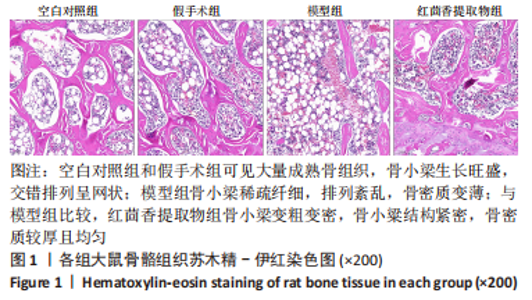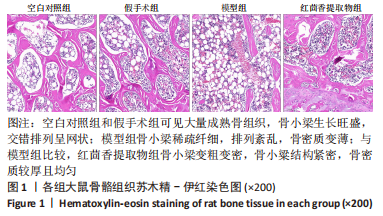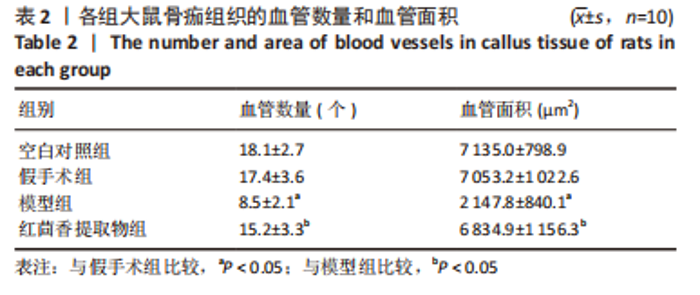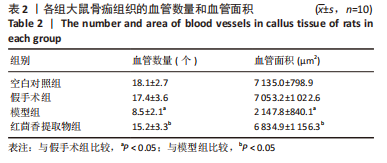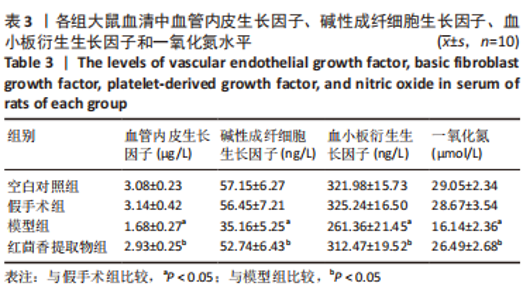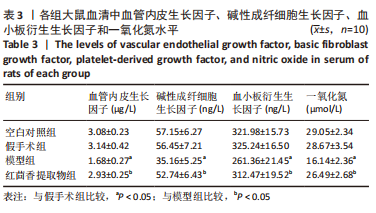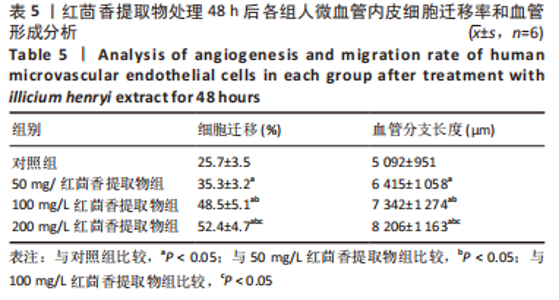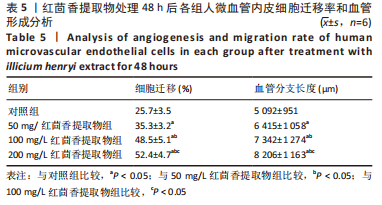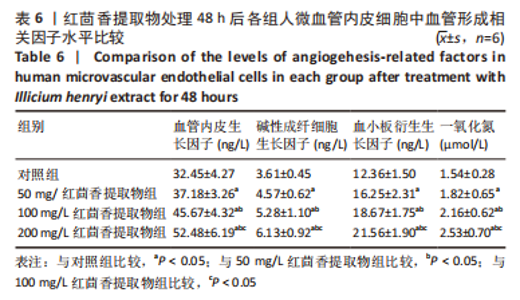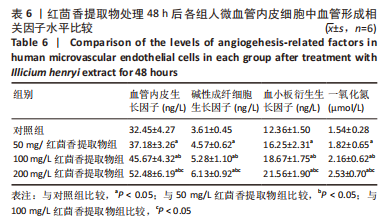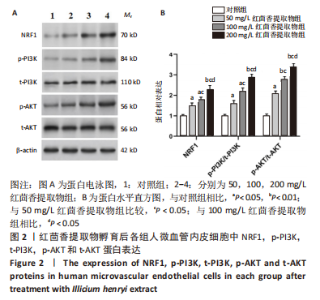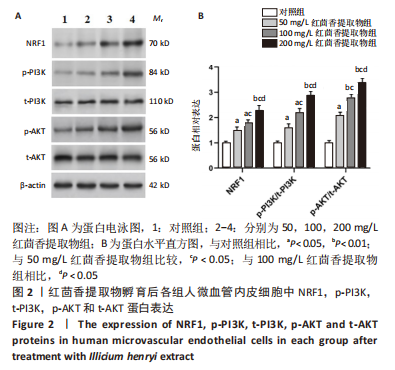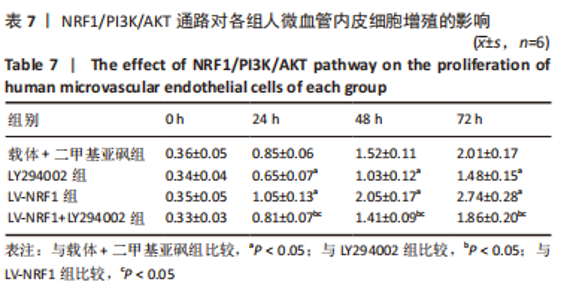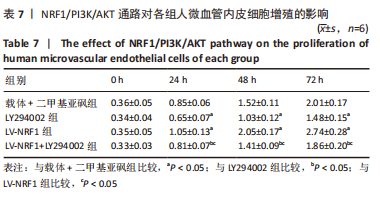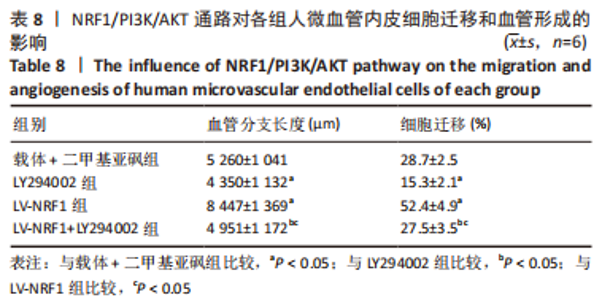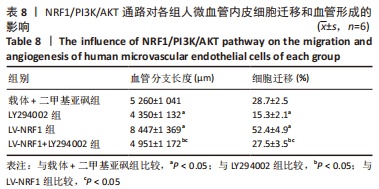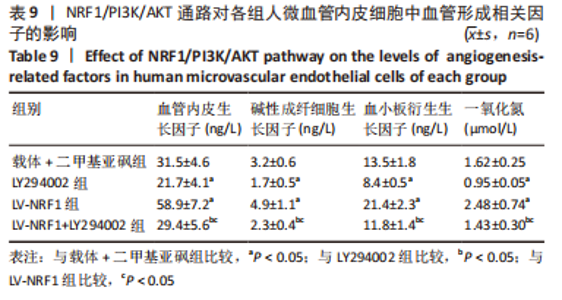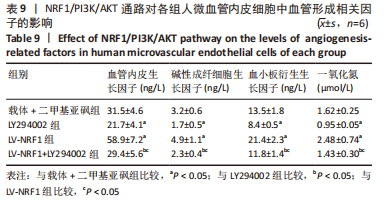Chinese Journal of Tissue Engineering Research ›› 2023, Vol. 27 ›› Issue (31): 5028-5034.doi: 10.12307/2023.513
Previous Articles Next Articles
Effect of Illicium henryi extract on angiogenesis in rats with osteoporotic fractures
Shi Guirong1, Ren Bowen2, Zhang Zhongbo2, Wang Lisha2, Zhang Qiwei2, Shi Dongliang2
- 1Department of Traditional Chinese Medicine, Clinical School of Shangqiu Medical College, Shangqiu 476000, Henan Province, China; 2First Department of Orthopedics, Henan Provincial Hospital of Traditional Chinese Medicine, Zhengzhou 450000, Henan Province, China
-
Received:2022-04-14Accepted:2022-08-08Online:2023-11-08Published:2023-01-31 -
Contact:Shi Dongliang, Master, Associate chief physician, First Department of Orthopedics, Henan Provincial Hospital of Traditional Chinese Medicine, Zhengzhou 450000, Henan Province, China -
About author:Shi Guirong, Master, Associate professor, Department of Traditional Chinese Medicine, Clinical School of Shangqiu Medical College, Shangqiu 476000, Henan Province, China
CLC Number:
Cite this article
Shi Guirong, Ren Bowen, Zhang Zhongbo, Wang Lisha, Zhang Qiwei, Shi Dongliang. Effect of Illicium henryi extract on angiogenesis in rats with osteoporotic fractures[J]. Chinese Journal of Tissue Engineering Research, 2023, 27(31): 5028-5034.
share this article
Add to citation manager EndNote|Reference Manager|ProCite|BibTeX|RefWorks
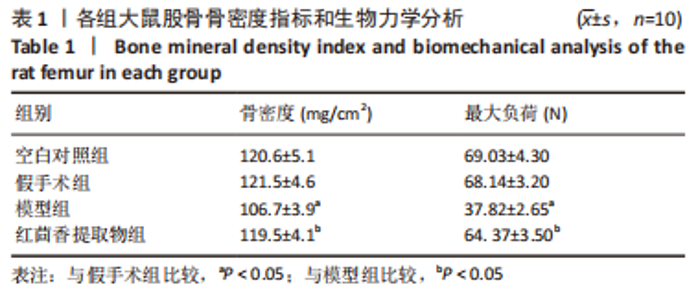
2.1.3 红茴香提取物对各组大鼠股骨骨密度和生物力学指标的影响 与空白对照组相比,假手术组大鼠的骨密度和股骨最大负荷差异均无显著性意义(P > 0.05);与假手术组相比,模型组大鼠骨密度和股骨最大负荷明显降低(P < 0.05);与模型组相比,红茴香提取物组大鼠骨密度和股骨最大负荷明显升高(P < 0.05),见表1。此外,苏木精-伊红染色结果分析显示,与空白对照组相比,假手术组大鼠的血管数量和血管面积差异无显著性意义(P > 0.05);与假手术组相比,模型组大鼠的血管数量和血管面积显著减少(P < 0.05);而红茴香提取物组的大鼠的血管数量增多,血管面积增大(P < 0.05),与假手术组相比差异无显著性意义,见表2。"
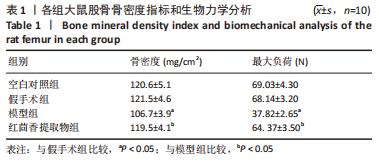
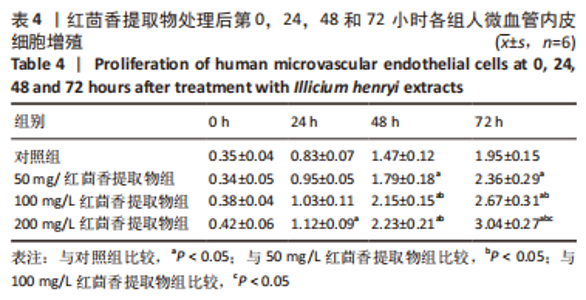
2.2 细胞实验结果 2.2.1 红茴香提取物对人微血管内皮细胞增殖和相关细胞因子水平的影响 与对照组相比,红茴香提取物组人微血管内皮细胞增殖和迁移率明显升高(P < 0.05),且200 mg/L红茴香提取物组人微血管内皮细胞增殖和迁移率大于50 mg/L和100 mg/L组;不同质量浓度的红茴香提取物处理人微血管内皮细胞 48 h后血管分支长度明显升高(P < 0.05),且200 mg/L红茴香提取物组细胞血管分支长度大于50 mg/L和100 mg/L组,见表4,5。此外,与对照组相比,红茴香提取物组细胞培养液中血管内皮生长因子、碱性成纤细胞生长因子、血小板衍生生长因子和一氧化氮水平明显升高(P < 0.05),且200 mg/L红茴香提取物组升高的幅度最大,见表6。"
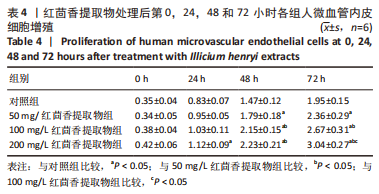

2.2.3 NRF1/PI3K/AKT通路对人微血管内皮细胞中相关细胞因子水平的影响 ①与Vector+二甲基亚砜组相比,PI3K抑制剂LY294002处理组人微血管内皮细胞中p-PI3K和p-AKT蛋白表达水平明显降低(P < 0.05),而NRF1蛋白表达水平没有明显变化(P > 0.05),细胞增殖和迁移率明显降低(P < 0.05),人微血管内皮细胞血管分支长度明显降低(P < 0.05),且细胞培养液上清中血管内皮生长因子、碱性成纤细胞生长因子、血小板衍生生长因子和一氧化氮水平明显降低(P < 0.05);LV-NRF1组人微血管内皮细胞中NRF1、p-PI3K和p-AKT蛋白表达水平明显升高(P < 0.05),细胞增殖和迁移率明显升高(P < 0.05),人微血管内皮细胞血管分支长度和细胞培养液上清中血管内皮生长因子、碱性成纤细胞生长因子、血小板衍生生长因子和一氧化氮水平明显升高(P < 0.05);②与LY294002组相比,LV-NRF1+LY294002组人微血管内皮细胞中p-PI3K和p-AKT蛋白表达水平明显降低(P < 0.05),而NRF1蛋白表达水平没有明显变化(P > 0.05),细胞增殖和迁移率明显升高(P < 0.05),人微血管内皮细胞血管分支长度和细胞培养液上清中血管内皮生长因子、碱性成纤细胞生长因子、血小板衍生生长因子和一氧化氮水平明显升高(P < 0.05);③与LV-NRF1组相比,LV-NRF1+LY294002组人微血管内皮细胞增殖和迁移率明显降低(P < 0.05),人微血管内皮细胞血管分支长度和细胞培养液上清中血管内皮生长因子、碱性成纤细胞生长因子、血小板衍生生长因子和一氧化氮水平明显降低(P < 0.05)。见图3,表7-9。"
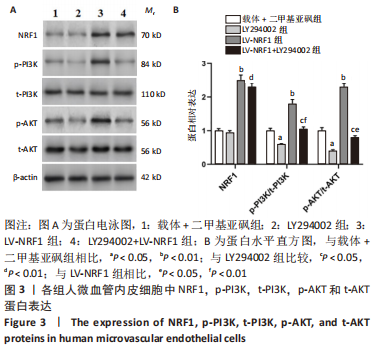
| [1] LIU R, CHAO A, WANG K, et al. Incidence and risk factors of medical complications and direct medical costs after osteoporotic fracture among patients in China. Arch Osteoporos. 2018;13(1):12. [2] BLIUC D, NGUYEN ND, NGUYEN TV, et al. Compound risk of high mortality following osteoporotic fracture and refracture in elderly women and men. J Bone Miner Res. 2013;28(11):2317-2324. [3] 王小璐, 崔宇,张令强. 促进骨折愈合的治疗策略及机制研究进展[J].生命科学,2021,33(1):121-130. [4] OLIVEIRA CS, CARREIRA M, CORREIA CR, et al. The Therapeutic Potential of Hematopoietic Stem Cells in Bone Regeneration. Tissue Eng Part B Rev. 2022;28(2):379-392. [5] DING L, GU S, ZHOU B, et al. Ginsenoside Compound K Enhances Fracture Healing via Promoting Osteogenesis and Angiogenesis. Front Pharmacol. 2022;13:855393. [6] RAMASAMY SK, KUSUMBE AP, WANG L, et al. Endothelial Notch activity promotes angiogenesis and osteogenesis in bone. Nature. 2014;507(7492): 376-380. [7] BAI J, LI L, KOU N, et al. Low level laser therapy promotes bone regeneration by coupling angiogenesis and osteogenesis. Stem Cell Res Ther. 2021;12(1): 432. [8] RAMIREZ-GARCIALUNA JL, RANGEL-BERRIDI K, OLASUBULUMI OO, et al. Enhanced Bone Remodeling After Fracture Priming. Calcif Tissue Int. 2022; 110(3):349-366. [9] 闵旸. 红茴香注射液消炎镇痛作用的研究[C]. 中国药理学会第九届制药工业药理学术会议论文摘要汇编. 海口:2000. [10] WANG S, QU W, LI T, et al. Xiangqing anodyne spray (XQAS): a combination of ethanol extracts of Cynanchum paniculatum and Illicium henryi for treating soft-tissue injury. Int J Clin Exp Med. 2015;8(8):12716-12725. [11] 成程,陈向梅,马健,等.用HPLC法测定红茴香注射液中槲皮苷的含量[J]. 药学实践杂志,2021,39(5):447-448+453. [12] WONG SK, CHIN KY,IMA-NIRWANA S. Quercetin as an Agent for Protecting the Bone: A Review of the Current Evidence.Int J Mol Sci. 2020;21(17):6448. [13] DULUC L, JACQUES C, SOLETI R, et al. Delphinidin inhibits VEGF induced-mitochondrial biogenesis and Akt activation in endothelial cells. Int J Biochem Cell Biol. 2014;53:9-14. [14] ISLAM MS, MIAO L, YU H, et al. Ethanol Extract of Illicium henryi Attenuates LPS-Induced Acute Kidney Injury in Mice via Regulating Inflammation and Oxidative Stress. Nutrients. 2019;11(6):1412. [15] YANG J, GAO J, GAO F, et al. Extracellular vesicles-encapsulated microRNA-29b-3p from bone marrow-derived mesenchymal stem cells promotes fracture healing via modulation of the PTEN/PI3K/AKT axis. Exp Cell Res. 2022;412(2):113026. [16] LIU Y, LIU J, XIA T, et al. MiR-21 promotes fracture healing by activating the PI3K/Akt signaling pathway. Eur Rev Med Pharmacol Sci. 2019;23(7):2727-2733. [17] KARAR J,MAITY A. PI3K/AKT/mTOR Pathway in Angiogenesis. Front Mol Neurosci. 2011;4:51. [18] YOUSEFZADEH N, KASHFI K, JEDDI S, et al. Ovariectomized rat model of osteoporosis: a practical guide. EXCLI J. 2020;19:89-107. [19] 谭张奎, 向楠, 张妍, 等. 基于IL-6/JAK2/STAT3通路探讨补肾化痰方改善去势大鼠骨丢失的作用机制[J]. 中草药,2021,52(16):4904-4912. [20] 吴倩, 黄珂, 彭诗亚, 等. Slit2在OVA/+SEB小鼠特应性皮炎模型炎性浸润,血管新生中的作用[J]. 免疫学杂志,2022,38(5):9. [21] YU H, LIU P, ZUO W, et al. Decreased angiogenic and increased apoptotic activities of bone microvascular endothelial cells in patients with glucocorticoid-induced osteonecrosis of the femoral head. BMC Musculoskelet Disord. 2020;21(1):277. [22] WANG D, LIU N, GAO Y, et al. Association Between Metabolic Syndrome and Osteoporotic Fracture in Middle-aged and Elderly Chinese Peoples. Cell Biochem Biophys. 2014;70(2):1297-303. [23] ZHAN Q, GUI X, WANG F, et al. Sialoglycoprotein isolated from the eggs of Gadus morhua enhances fracture healing in osteoporotic mice. Food Funct. 2017;8(3):1094-1104. [24] KAWAKAMI Y, II M, MATSUMOTO T,et al. A small interfering RNA targeting Lnk accelerates bone fracture healing with early neovascularization. Lab Invest. 2013;93(9):1036-1053. [25] 李翠艳, 刘阳阳, 史丽萍, 等. 红茴香现代研究进展[J]. 湖南中医杂志, 2012,28(6):150-152. [26] 李殿菊, 廖益飞,方明宇. 红茴香中毒致癫痫样发作5例[J]. 药物流行病学杂志,1994(4):201. [27] 王云琴. 红茴香针剂导致严重心律失常2例[J]. 药物不良反应杂志, 1999,1(3):188. [28] 浦天仇, 陈志康, 施赛荷, 等. 红茴香注射液的毒性研究(第五报)[J]. 温州医学院学报,1980(2): 32-35. [29] YU-PING, ZHU, ZHENG, et al. Unification of Opposites between Two Antioxidant Transcription Factors Nrf1 and Nrf2 in Mediating Distinct Cellular Responses to the Endoplasmic Reticulum Stressor Tunicamycin. Antioxidants (Basel). 2019;9(1):4. [30] WEI Y, GONG J, XU Z, et al. Nrf2 promotes reparative angiogenesis through regulation of NADPH oxidase-2 in oxygen-induced retinopathy. Free Radic Biol Med. 2016;99:234-243. [31] WANG L, FENG Y, XIE X, et al. Neuropilin-1 Aggravates Liver Cirrhosis by Promoting Angiogenesis Via VEGFR2-Dependent PI3K/Akt Pathway in Hepatic Sinusoidal Endothelial Cells. EBioMedicine. 2019;43:525-536. |
| [1] | Li Xiaomin, Tian Xiangdong, Tan Yetong, Zhu Guangyu, Wang Rongtian, Wang Jian, Xue Zhipeng, Ma Sheng, Hu Yuanyi, Huang Ye, Ding Tiansong. Changes of lower limb force line and knee function after high tibial osteotomy in osteoporotic medial ventricular knee osteoarthritis [J]. Chinese Journal of Tissue Engineering Research, 2023, 27(9): 1325-1329. |
| [2] | Wu Taoguang, Nie Shaobo, Chen Hua, Zhu Zhengguo, Qi Lin, Tang Peifu. Biomechanical characteristics of a new multi-dimensional cross locking plate in the treatment of subtrochanteric nonunion [J]. Chinese Journal of Tissue Engineering Research, 2023, 27(9): 1330-1334. |
| [3] | Peng Zhixin, Yan Wengang, Wang Kun, Zhang Zhenjiang. Finite element analysis and structural optimization design of 3D printed forearm braces [J]. Chinese Journal of Tissue Engineering Research, 2023, 27(9): 1340-1345. |
| [4] | Zheng Hongrui, Zhang Wenjie, Wang Yunhua, He Bin, Shen Yajun, Fan Lei. Femoral neck system combined with platelet-rich plasma in the treatment of femoral neck fracture [J]. Chinese Journal of Tissue Engineering Research, 2023, 27(9): 1390-1395. |
| [5] | Zheng Bo, Zhang Xiuli, Zhou Hao, He Zebi, Zhou Jin, Zhou Weiyun, Li Peng. Arthroscopy-assisted locking hollow screw fixation and open reduction plate internal fixation in the treatment of Schatzker II-III tibial plateau fractures: early CT evaluation [J]. Chinese Journal of Tissue Engineering Research, 2023, 27(9): 1410-1416. |
| [6] | Jiang Xiaocheng, Shi Lu, Wang Yinbin, Li Qiujiang, Xi Chuangzhen, Ma Zefeng, Cai Lijun. Systematical evaluation of bone fusion rate after interbody fusion in patients with osteoporosis and lumbar degenerative disease treated with teriparatide [J]. Chinese Journal of Tissue Engineering Research, 2023, 27(9): 1427-1433. |
| [7] | Sun Jiajia, Zhu Haidi, Lu Yun, Zhang Kai. Comparison of bone metabolism markers between type 2 diabetes mellitus and non-type 2 diabetes mellitus patients with hip fracture [J]. Chinese Journal of Tissue Engineering Research, 2023, 27(8): 1156-1160. |
| [8] | Zhao Wei, Feng Wei, Yang Tieyi, Ren Wei, Wang Yuxin, Lyu Huicheng, Chang Zhiqiang, Feng Xiaodong, Wang Ziheng, Guo Shibing. Antibiotic bone cement intramedullary nail prepared using 3D printed mold for the treatment of long bone infection in lower limbs [J]. Chinese Journal of Tissue Engineering Research, 2023, 27(7): 1023-1030. |
| [9] | Zhang Wei, Huang Zhichao, Zhao Ruifeng, Liang Huan, Ma Yufeng, Shen Yanguang, Zhong Honggang, Chen Zhaojun, Zhang Jichuan, Chen Weiheng. Efficacy of gutta-percha splint on a rabbit fracture model [J]. Chinese Journal of Tissue Engineering Research, 2023, 27(7): 1055-1061. |
| [10] | Huang Guijiang, Ji Yuwei, Zhao Xin, Yang Yi, Zhao Yulan, Wang Peijin, Tang Wei, Jiao Jianlin. Effect and mechanism of different administration routes of placenta-derived mesenchymal stem cells in the treatment of tree shrews with osteoporotic fracture [J]. Chinese Journal of Tissue Engineering Research, 2023, 27(6): 909-914. |
| [11] | Long Yanming, Xie Mengsheng, Huang Jiajie, Xue Wenli, Rong Hui, Li Xiaojie. Casein kinase 2-interaction protein-1 regulates the osteogenic ability of bone marrow mesenchymal stem cells in osteoporosis rats [J]. Chinese Journal of Tissue Engineering Research, 2023, 27(6): 878-882. |
| [12] | Zhang Min, Zhang Xiaoming, Liu Tongbin. Application potential of naringin in bone tissue regeneration [J]. Chinese Journal of Tissue Engineering Research, 2023, 27(5): 787-792. |
| [13] | Wang Jinling, Huang Xiarong, Qu Mengjian, Huang Fujin, Yin Lingwei, Zhong Peirui, Liu Jin, Sun Guanghua, Liao Yang, Zhou Jun. Effects of exercise training on bone mass and bone microstructure in aged osteoporotic rats [J]. Chinese Journal of Tissue Engineering Research, 2023, 27(5): 676-682. |
| [14] | Zhou Changjun, Long Shengli, Zou Wei, Xiao Jie, Long Hao, Feng Mingxing, Zhang Yang, Liu Jie, Zeng Zhongwei. Design and clinical application of coplanar screw guide for percutaneous pedicle screw in the treatment of thoracolumbar fracture [J]. Chinese Journal of Tissue Engineering Research, 2023, 27(4): 534-538. |
| [15] | Chen Lei, Jia Yanfei, Lyu Huicheng, Zhang Lifeng. Application of T-shaped plate for fractures involving the quadrilateral region of acetabulum [J]. Chinese Journal of Tissue Engineering Research, 2023, 27(4): 578-582. |
| Viewed | ||||||
|
Full text |
|
|||||
|
Abstract |
|
|||||
